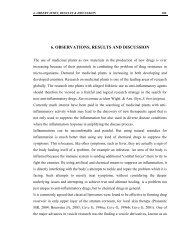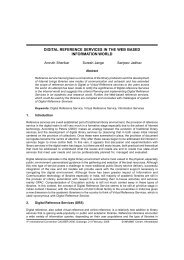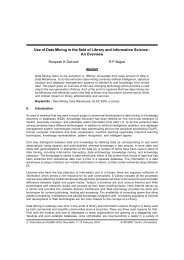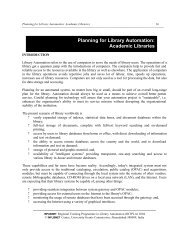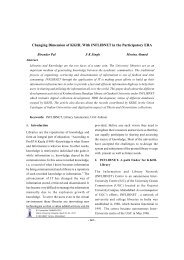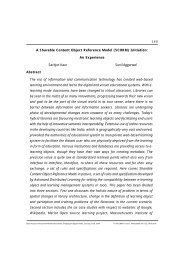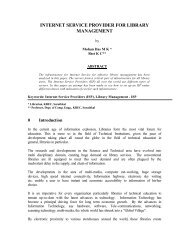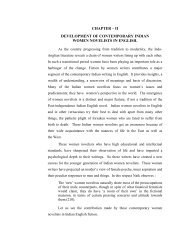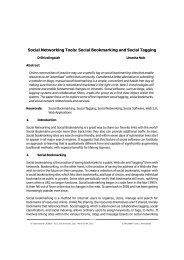role of digital information services in corporate libraries - INFLIBNET ...
role of digital information services in corporate libraries - INFLIBNET ...
role of digital information services in corporate libraries - INFLIBNET ...
You also want an ePaper? Increase the reach of your titles
YUMPU automatically turns print PDFs into web optimized ePapers that Google loves.
160<br />
PLANNER-2007<br />
ROLE OF DIGITAL INFORMATION SERVICES IN CORPORATE LIBRARIES<br />
Pradnya Choughule<br />
Abstract<br />
Present paper expla<strong>in</strong>s the <strong>role</strong> <strong>of</strong> <strong>digital</strong> <strong><strong>in</strong>formation</strong> <strong>services</strong> <strong>in</strong> <strong>corporate</strong> <strong>libraries</strong>. The <strong>in</strong>troduction<br />
to <strong>digital</strong> <strong><strong>in</strong>formation</strong> has added a new dimension to <strong><strong>in</strong>formation</strong> technology, which gave birth to<br />
new concept <strong>of</strong> <strong>digital</strong> <strong><strong>in</strong>formation</strong> <strong>services</strong>. Corporate <strong>libraries</strong> have different users with different<br />
requirements. The methodology used for this paper is a literature survey and observation. It discusses<br />
how the effective and efficient use <strong>of</strong> new technologies helps us to improve the library’s image.<br />
Digital <strong><strong>in</strong>formation</strong> <strong>services</strong> provide a wide array <strong>of</strong> <strong>services</strong> to assist members <strong>of</strong> the library with<br />
organis<strong>in</strong>g material or mak<strong>in</strong>g them more widely available. Today the trend is quickly shift<strong>in</strong>g towards<br />
computerisation. Library whether big or small tries <strong>in</strong> to provide better or more accurate <strong>services</strong> to<br />
its end users at m<strong>in</strong>imum cost and time.<br />
Keywords : Digital Information Services, Corporate Library, Digital Information, Electronic Resources,<br />
Internet<br />
1. Introduction<br />
Contemporary society has experienced an extraord<strong>in</strong>ary explosion <strong>in</strong> <strong><strong>in</strong>formation</strong> which has resulted<br />
<strong>in</strong> a correspond<strong>in</strong>g <strong>in</strong>crease <strong>in</strong> the publication <strong>of</strong> books and other materials which acts as <strong><strong>in</strong>formation</strong><br />
carriers. The effective and efficient use <strong>of</strong> new technology helps us to improve the library’s image.<br />
One <strong>of</strong> the basic functions <strong>of</strong> library is to make its resources readily available to its users. In this<br />
<strong><strong>in</strong>formation</strong> age, ICT is play<strong>in</strong>g a very vital <strong>role</strong> for dissem<strong>in</strong>at<strong>in</strong>g <strong><strong>in</strong>formation</strong> to the users <strong>in</strong> the<br />
networked environment. Internet, WWW, <strong>digital</strong> library, electronic journals, and onl<strong>in</strong>e databases<br />
are all such developments, which are chang<strong>in</strong>g the way <strong>libraries</strong> function today. Today’s chang<strong>in</strong>g<br />
and extremely advanc<strong>in</strong>g technological environment requires everyth<strong>in</strong>g to be advanced. To cope<br />
with this type <strong>of</strong> environment every field is suppose to accept the change and implement new<br />
emerg<strong>in</strong>g technology <strong>in</strong> it, so is the case <strong>of</strong> <strong>libraries</strong>.<br />
2. Digital Information Services<br />
Libraries are provid<strong>in</strong>g <strong><strong>in</strong>formation</strong> to its user. Earlier it was <strong>in</strong> the form <strong>of</strong> reference service which<br />
is more concern with provision <strong>of</strong> <strong><strong>in</strong>formation</strong> on demand, but <strong><strong>in</strong>formation</strong> <strong>services</strong> lays emphasis<br />
on provid<strong>in</strong>g <strong><strong>in</strong>formation</strong> <strong>in</strong> anticipation. In <strong><strong>in</strong>formation</strong> <strong>services</strong> emphasis is to provide <strong><strong>in</strong>formation</strong><br />
rather than provid<strong>in</strong>g only document. It is an attempt to provide exact <strong><strong>in</strong>formation</strong> not just direct<strong>in</strong>g<br />
to the material. Ultimately, the librarian is not wait<strong>in</strong>g for the user, but goes ahead with the job.<br />
5 th Convention PLANNER -2007, Gauhati University, Guwahati, December 7-8, 2007 © <strong>INFLIBNET</strong> Centre, Ahmedabad
161<br />
With the advent <strong>of</strong> ICT, <strong>libraries</strong> implement it <strong>in</strong> provid<strong>in</strong>g <strong><strong>in</strong>formation</strong> <strong>services</strong> too, which <strong>in</strong>troduces<br />
the concept <strong>of</strong> ‘Digital Information Services’.<br />
Digital Information Services <strong>in</strong> the <strong>libraries</strong> <strong>in</strong>cludes all electronic <strong><strong>in</strong>formation</strong> resources<br />
oraganised for <strong>services</strong>, as well as computerized and networked onl<strong>in</strong>e resources accessed<br />
through <strong>libraries</strong>.<br />
• Electronic Information Resources – e-books, e-journals, CDs, DVDs and databases, etc.<br />
• Computerised and networked onl<strong>in</strong>e resources – several reputed and authentic sources are<br />
available on the Internet. The convenience <strong>of</strong> access<strong>in</strong>g remote <strong><strong>in</strong>formation</strong> through WWW has<br />
resulted <strong>in</strong> popularity for WWW. Hence, most <strong>of</strong> organizations, publishers, open archive <strong>in</strong>itiatives<br />
have come forward to put their <strong><strong>in</strong>formation</strong> content on web.<br />
The convergence <strong>of</strong> computer, telecommunication, <strong><strong>in</strong>formation</strong> and multimedia has helped <strong>in</strong> the<br />
development <strong>of</strong> <strong>digital</strong> <strong><strong>in</strong>formation</strong> <strong>services</strong>. Digital <strong><strong>in</strong>formation</strong> <strong>services</strong> provides a wide array <strong>of</strong><br />
<strong>services</strong> to assist members <strong>of</strong> the library with organiz<strong>in</strong>g collection <strong>of</strong> material or mak<strong>in</strong>g them<br />
more widely available.<br />
Follow<strong>in</strong>g are some <strong>of</strong> the Digital Information Services<br />
• Electronic Table <strong>of</strong> content service<br />
• Full text access to electronic journals<br />
• Current awareness <strong>services</strong><br />
• Electronic document delivery<br />
• Externally purchased database<br />
• CD-ROM Databases<br />
• Library catalogues<br />
• Remote Information <strong>services</strong><br />
• Internally published newsletters, reports, journals<br />
• Bullet<strong>in</strong> Board Services<br />
• Discussion groups & forums<br />
• Newspaper clipp<strong>in</strong>gs<br />
In <strong>corporate</strong> <strong>libraries</strong> follow<strong>in</strong>g <strong>services</strong> are more popular and common among the above all -
162<br />
• Library E-mail Distribution Service<br />
News about the client’s technologies, organization, etc. Library prepares bullet<strong>in</strong>s which are<br />
specific to the clients or technologies, etc. Basically, they cover the subject area <strong>of</strong> the company<br />
or organization for which they are work<strong>in</strong>g. These <strong>in</strong>ternal newsletters hav<strong>in</strong>g frequency like<br />
daily, weekly, fortnightly, etc. the dissem<strong>in</strong>ation is done through e-mail.<br />
• Table <strong>of</strong> Contents<br />
This <strong>in</strong>cludes circulation <strong>of</strong> TOC <strong>of</strong> popular management and technical journals.<br />
• Selective Dissem<strong>in</strong>ation <strong>of</strong> Information<br />
On demand <strong><strong>in</strong>formation</strong> dissem<strong>in</strong>ation service on topics chosen by clients. Users may easily<br />
select topics <strong>of</strong> <strong>in</strong>terest and construct a pr<strong>of</strong>ile<br />
• Newspaper Clipp<strong>in</strong>gs<br />
Scanned and downloaded articles <strong>of</strong> company doma<strong>in</strong> are posted on library portal.<br />
• Onl<strong>in</strong>e Access to Databases<br />
Many <strong>corporate</strong> <strong>libraries</strong> are provid<strong>in</strong>g onl<strong>in</strong>e access to various purchased databases to its<br />
users.<br />
3. Role <strong>of</strong> Digital Information Services <strong>in</strong> Today’s Libraries<br />
A large number <strong>of</strong> <strong>services</strong> are <strong>of</strong>fered to users by library and <strong><strong>in</strong>formation</strong> centers today. While the<br />
format <strong>of</strong> <strong><strong>in</strong>formation</strong> resources may change, the way <strong>of</strong> access<strong>in</strong>g <strong><strong>in</strong>formation</strong> too may vary and<br />
the style <strong>of</strong> serv<strong>in</strong>g the user may be different but still the vision and mission <strong>of</strong> library will be same.<br />
For some users, a major advantage <strong>in</strong> us<strong>in</strong>g a <strong>digital</strong> <strong><strong>in</strong>formation</strong> <strong>services</strong> is the ability to ‘personalise’<br />
the <strong><strong>in</strong>formation</strong> that appears on their desktop or laptop, computer. Library’s <strong>role</strong> is also enhanced<br />
where they will have to adapt to the chang<strong>in</strong>g environment.<br />
Commercial search eng<strong>in</strong>es like Google, yahoo, <strong><strong>in</strong>formation</strong> gateways have assisted the librarians<br />
<strong>in</strong> meet<strong>in</strong>g the <strong><strong>in</strong>formation</strong> needs <strong>of</strong> their clientele.<br />
Libraries are no longer bound with their own <strong><strong>in</strong>formation</strong> resources to provide <strong>services</strong> as they can<br />
easily get access to remote <strong><strong>in</strong>formation</strong> sources “just-<strong>in</strong>-time”. Libraries are <strong>in</strong>creas<strong>in</strong>gly design<strong>in</strong>g<br />
“portals” to facilitate the users access to the available resources. A portal can be def<strong>in</strong>ed as an<br />
<strong><strong>in</strong>formation</strong> hub or an entry po<strong>in</strong>t to <strong>digital</strong> <strong><strong>in</strong>formation</strong> sources and <strong>services</strong> available through the<br />
Internet and Intranets.<br />
To fulfill the mission <strong>of</strong> the library, it has to provide the traditional reference <strong>services</strong>, retrieval and<br />
dissem<strong>in</strong>ation <strong>of</strong> <strong><strong>in</strong>formation</strong> and at the same time, It has to stretch its <strong>services</strong> to <strong><strong>in</strong>formation</strong>
163<br />
search <strong>services</strong>, to organize the <strong><strong>in</strong>formation</strong> resources for easy access, to filter qualitative <strong><strong>in</strong>formation</strong><br />
from the vast ocean <strong>of</strong> World Wide Web,<br />
3.1. Advantages <strong>of</strong> Digital Information Services<br />
Ability to make an <strong><strong>in</strong>formation</strong> source simultaneously available to multiple users through networks<br />
removed the: one source – one user” limitation <strong>of</strong> the pr<strong>in</strong>t world.<br />
• It makes the library collection for global use.<br />
• It saves the time <strong>of</strong> the users.<br />
• It facilitate the effective function<strong>in</strong>g <strong>of</strong> the library.<br />
• It provides the latest and accurate <strong><strong>in</strong>formation</strong>.<br />
Digital Information Services will have no boundaries <strong>of</strong> time, space, geographical area, and racial<br />
discrim<strong>in</strong>ation between people for access<strong>in</strong>g the <strong><strong>in</strong>formation</strong>. One can access the <strong><strong>in</strong>formation</strong> from<br />
a remote area or from some other country also and at a very cheaper rate.<br />
4. Role <strong>of</strong> Digital Information Services <strong>in</strong> Corporate Libraries<br />
The Ma<strong>in</strong> aim <strong>of</strong> all <strong>libraries</strong> is to provide right <strong><strong>in</strong>formation</strong> to right user at right time, whether it is<br />
academic library, public library or a special library. Only the difference is <strong>in</strong> targeted audience. Their<br />
<strong><strong>in</strong>formation</strong> needs are different with different library. Here ma<strong>in</strong> focus is on <strong>corporate</strong> <strong>libraries</strong>.<br />
Corporate <strong>libraries</strong> are the body <strong>of</strong> <strong>corporate</strong> sector. It is an <strong>in</strong>dependent <strong>in</strong>vestment research firm.<br />
Corporate company’s ma<strong>in</strong>ly <strong>in</strong>cludes real estate, bank<strong>in</strong>g, IT firms, telecom <strong>in</strong>dustry, etc. These<br />
deals with many projects at one time. They require all <strong><strong>in</strong>formation</strong> and happen<strong>in</strong>g about their clients<br />
along with their own company. They require <strong><strong>in</strong>formation</strong> without spend<strong>in</strong>g much time. Thus, <strong>digital</strong><br />
<strong><strong>in</strong>formation</strong> <strong>services</strong> are must <strong>in</strong> <strong>corporate</strong> <strong>libraries</strong>, as the associates cannot spend much time <strong>in</strong><br />
search<strong>in</strong>g <strong><strong>in</strong>formation</strong> <strong>in</strong>stead they approach to library for their <strong><strong>in</strong>formation</strong> requirements.<br />
In <strong>corporate</strong> world, one organization deals with many clients for their projects, thus their <strong><strong>in</strong>formation</strong><br />
needs varies with the number <strong>of</strong> projects. Thus <strong>corporate</strong> librarians must have to take care <strong>of</strong> each<br />
project group requirements.<br />
By go<strong>in</strong>g for Digital Information Services the <strong>corporate</strong> library provide speedy access to qualitative<br />
<strong><strong>in</strong>formation</strong> resources.<br />
• It makes optimum utilization <strong>of</strong> available resources<br />
• It saves time <strong>of</strong> users<br />
• One can access <strong>digital</strong> <strong><strong>in</strong>formation</strong> from anywhere without restriction<br />
• It available at only one click, away.
164<br />
In the <strong>digital</strong> age, the <strong><strong>in</strong>formation</strong> and knowledge flow become even faster, and the popular value <strong>of</strong><br />
knowledge necessities as well as the need <strong>of</strong> <strong>corporate</strong> library or any associate or member will<br />
require more quantity and higher quality. Use <strong>of</strong> <strong>digital</strong> <strong><strong>in</strong>formation</strong> resources is now habitual and<br />
they would like to see more provision <strong>of</strong> <strong><strong>in</strong>formation</strong> <strong>in</strong> <strong>digital</strong> form. They appreciate very many<br />
efforts that <strong>libraries</strong> have made <strong>in</strong> this area. They recognize that utiliz<strong>in</strong>g the content <strong>of</strong> journals is<br />
now much easier than it used to be. Indeed users <strong>of</strong> <strong>corporate</strong> <strong>libraries</strong> want more. Users would like<br />
to f<strong>in</strong>d everyth<strong>in</strong>g they need <strong>in</strong> <strong>digital</strong> form. Users demand seamless access to a multitude <strong>of</strong> <strong>digital</strong><br />
<strong><strong>in</strong>formation</strong> <strong>services</strong> without leav<strong>in</strong>g their desktop computers. They prefer us<strong>in</strong>g systems that<br />
recognize them when they log on. Corporate <strong>libraries</strong> devote about 30% <strong>of</strong> their material acquisition<br />
budgets to electronic <strong><strong>in</strong>formation</strong> sources. Traditionally library <strong>services</strong> were ma<strong>in</strong>ly centralised but<br />
with the use <strong>of</strong> IT and networks makes delivery <strong>of</strong> <strong><strong>in</strong>formation</strong> <strong>services</strong> more distributed. Digital<br />
<strong><strong>in</strong>formation</strong> <strong>services</strong> is must <strong>in</strong> <strong>corporate</strong> as they require all <strong><strong>in</strong>formation</strong> at their ease. By go<strong>in</strong>g for<br />
<strong>digital</strong> library <strong>services</strong>, the <strong>corporate</strong> library can provide speedy access to qualitative <strong><strong>in</strong>formation</strong><br />
resources. Users <strong>of</strong> <strong>corporate</strong> library are very happy with <strong>digital</strong> <strong><strong>in</strong>formation</strong> <strong>services</strong> which provided<br />
by <strong>corporate</strong> <strong>libraries</strong>. Because <strong>in</strong> today’s <strong><strong>in</strong>formation</strong> world, librarians digg<strong>in</strong>g the <strong><strong>in</strong>formation</strong> as<br />
per their request, their <strong>in</strong>terest etc. Therefore, they don’t go while search<strong>in</strong>g the <strong><strong>in</strong>formation</strong> and<br />
they save their valuable time.<br />
5. Conclusion<br />
Today, the trend is quickly shift<strong>in</strong>g towards computerization. Library whether big or small is try<strong>in</strong>g to<br />
provide better or more accurate <strong>services</strong> to its end users at m<strong>in</strong>imum cost and time. Deliver<strong>in</strong>g<br />
<strong>digital</strong> <strong>services</strong> is about skills, confidence and a strong service ethics. This is someth<strong>in</strong>g <strong>corporate</strong><br />
<strong>libraries</strong> and <strong>corporate</strong> librarians have. These <strong>services</strong> br<strong>in</strong>g fresh challenges. Staff need to learn<br />
new skills. It is commonly said nowadays, with reference to scholar’s <strong><strong>in</strong>formation</strong> seek<strong>in</strong>g and use<br />
behavior that, unless someth<strong>in</strong>g is available <strong>in</strong> <strong>digital</strong> form it is <strong>in</strong>visible. There is a cont<strong>in</strong>u<strong>in</strong>g<br />
evolution <strong>of</strong> the <strong>role</strong>s and functions <strong>of</strong> <strong>libraries</strong> and librarians, which appears to parallel the growth<br />
<strong>of</strong> acceptance and use <strong>of</strong> the <strong>digital</strong> <strong><strong>in</strong>formation</strong> by library pr<strong>of</strong>essionals. Digital Information Services<br />
has become a part <strong>of</strong> library environment today. Thus, Digital Information Services <strong>in</strong> the library are<br />
ga<strong>in</strong><strong>in</strong>g popularity.<br />
References<br />
[1] Brophy, Peter. Library <strong>in</strong> the 21st century : new service for the <strong><strong>in</strong>formation</strong> age. Library Assn<br />
Pub. Ltd, 2003<br />
[2] Das, Subarna and Jana, Shibsankar. Chang<strong>in</strong>g Role Of Onl<strong>in</strong>e Information Services In The<br />
Digital Enviornment : International Convention CALIBER-2006, Gulbarga, 2-4 February, 2006,<br />
pp. 128-141
165<br />
[3] Husler, R.P. (1996), Digital library: content preservation <strong>in</strong> <strong>digital</strong> world. DESIDOC Bullet<strong>in</strong> <strong>of</strong><br />
Information Technology, Vol. 16 No. 1, pp. 31-9.<br />
[4] Ingwersen, Peter, The Role <strong>of</strong> Libraries and Librarians <strong>in</strong> Organis<strong>in</strong>g Digital Information. Libri,<br />
1999, vol. 49, pp. 11–15<br />
[5] Kuny, Terry & Cleveland, Gary (1998) “The Digital Library: Myths and Challenges”.IFLA<br />
Journal, 24(2), pp. 107-113,<br />
[6] Lyer, H . Electronic resources: use and user behaviour. Reference Librarian. Vol.60, 1998,<br />
pp.1-17.<br />
[7] Sharma, P.C., & Arora, I.P. (2005). Build<strong>in</strong>g a <strong>digital</strong> library: a need <strong>of</strong> present environment.<br />
Herald <strong>of</strong> Library Science, 44, pp. 39-44.<br />
[8] Sirurmath, Sengupta. Electronic <strong>libraries</strong>. New Delhi: Allied Publishers, 2002<br />
[9] Sreenivasulu, V. The <strong>role</strong> <strong>of</strong> a <strong>digital</strong> librarian <strong>in</strong> the management <strong>of</strong> <strong>digital</strong><br />
<strong><strong>in</strong>formation</strong> systems (DIS). The Electronic Library Volume 18. Number 1. 2000. pp. 12-20<br />
ABOUT AUTHOR<br />
Ms. Pradnya Choughule is presently work<strong>in</strong>g as Officer, Library & Information Center <strong>in</strong> Tata<br />
Consultancy Services Ltd. Mumbai. She has completed her ‘Masters Degree with first class First<br />
(2005-06) from Mumbai University, Mumbai with project on ‘Retrospective Conversion <strong>of</strong> Library<br />
Database’. Her areas <strong>of</strong> specialisation are <strong><strong>in</strong>formation</strong> <strong>services</strong> and knowledge management.




